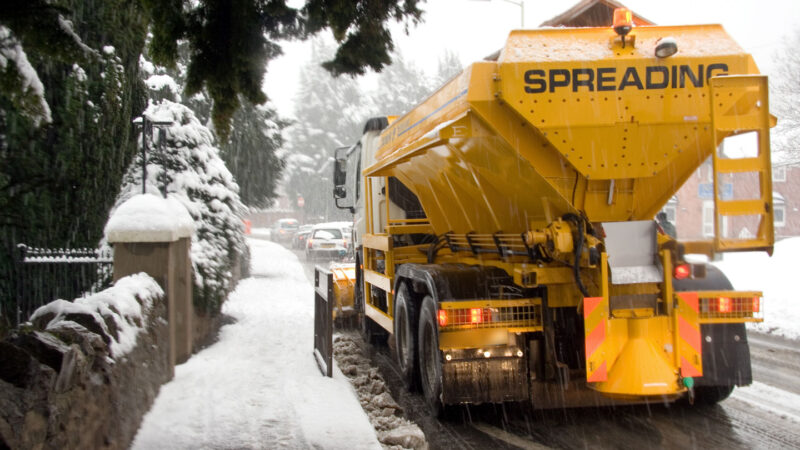If you have ever made homemade ice cream the old-fashioned way using a hand-crank machine, you probably know that you need ice and rock salt to make the cream mixture cold enough to freeze. Similarly, if you live in a cold climate, you may have seen the trucks that salt and sand the streets after a snowfall to prevent ice from building up on the roads. In both of these instances, salt is acting to lower the freezing point of water and changing what phase of matter the water is (i.e., turning solid ice into liquid water).
For the ice cream maker, because the rock salt lowers the freezing point of the ice, the temperature of the ice/rock salt mixture can drop below the normal freezing point of water. This makes it possible to freeze the ice cream mixture in the inner container of the ice cream machine. For the salt spread on streets in wintertime, the lowered freezing point means that snow and ice can melt even when the weather is below the normal freezing point of water. Both the ice cream maker and road salt are examples of freezing point depression.
Table salt (sodium chloride, or NaCl) mixed with water is an example of a chemical solution. In a solution, there is a solvent (the water in this example) and a solute (the salt in this example). A molecule of the solute dissolves (goes into solution) because the force of attraction between the solute molecule and the solvent molecules is greater than the force of attraction between the molecules of the solute. Water (H2O) is a good solvent because it is partially polarized. (This polarization is caused by the distribution of electrons in the water molecule. Specifically, its hydrogen ends have a partial positive charge, and the oxygen end has a partial negative charge.)
Because water molecules are partially polarized, it is possible for them to arrange themselves around ions (which are molecules or atoms that have a charge), like the sodium (Na+) and chloride (Cl–) ions that make up table salt. This is why there is a greater attraction between the water molecules and the molecules of salt than there is between the molecules of salt by themselves, and why the water can dissolve the salt to create a salty solution.
Other substances when mixed with water can also lower its freezing point. The amount by which the freezing point is lowered depends only on the number of molecules dissolved, not on their chemical nature. This is an example of a colligative property.
In this science project, you will investigate different substances to see how they affect the rate at which ice cubes melt. You will test substances that dissolve in water (i.e., soluble substances), like salt and sugar, as well as a substance that does not dissolve in water (i.e., an insoluble substance), specifically sand. Which substances will speed up the melting of the ice?
Terms and concepts
Freezing point
Phases of matter
Freezing point depression
Solution
Solute
Solvent
Molecules
Colligative properties
Questions
What is freezing point depression? When does it happen?
How are solutions made?
Which of the suggested test substances are soluble in water?
Which of the suggested test substances are insoluble in water?
Resources
For more information on colligative properties, see:
Nave, C.R. (2006). Colligative Properties of Solutions. HyperPhysics, Department of Physics and Astronomy, Georgia State University. Retrieved September 6, 2007.
For information on Avogadro’s number and molecular weight, see:
Lachish, U. (2000). Avogadro’s Number, Atomic and Molecular Weight. Retrieved September 6, 2007.
Materials and equipment
Science Buddies’ recommended supplies for this project can be found at Amazon.com.
Identical bowls or saucers (4)
Ice cubes (12) of the same size and shape
Salt (¾ teaspoon)
Sugar (¾ teaspoon)
Sand (¾ teaspoon)
¼ teaspoon measuring spoon
Timer or clock
Empty refrigerator shelf that can hold all four bowls, unstacked, at the same time
50 milliliter graduated cylinder, or smaller size
Large cup with a spout, such as some measuring cups, or a funnel that fits in the graduated cylinder
Optional: Masking tape and a permanent marker for labeling the bowls
Lab notebook
Experimental procedure
Tip for science fair participants: As you do your experiment, take a few pictures of yourself in action and of your experimental setup. Use the pictures to help make your science fair display board more interesting and informative.
1. Get the salt, sugar, sand and measuring teaspoon ready to use nearby.
Once you have set up the ice cubes in their bowls, you will want to quickly add the substances to the ice cubes so that they do not melt before adding the substances.
2. Into each of the four bowls, quickly place three ice cubes. Arrange the ice cubes so that only the corners are touching, forming a triangular shape, as shown in Figure 1.
Tip: If you are using ice cubes from a tray, it helps to let the tray sit at room temperature a little (for about five minutes) so that the ice cubes more easily come out of the tray and do not break into pieces.
3. Carefully sprinkle ½ teaspoon (tsp.) of salt over the ice cubes in one bowl, as shown in Figure 2. Then sprinkle ½ tsp. of sugar over the ice cubes in another bowl and ½ tsp. of sand over the ice cubes in the third bowl. Do not sprinkle anything over the ice cubes in the fourth bowl — it will be your control.
4. Move each bowl to an empty shelf in the refrigerator. If any of the ice cubes no longer form a triangular shape in their bowl, gently nudge the ice cubes to make a triangle again.
You are doing this experiment in the refrigerator because it is easier to see the effects of colligative properties at colder temperatures. To think about why this is, imagine melting an ice cube on a hot, paved road compared to melting it in the refrigerator. The hot temperature of the road will make all of the ice cubes melt very quickly, which makes it harder to see the relatively minor effects of colligative properties on how fast the ice cubes melt.
5. Note the starting time in your lab notebook. Tell other people who may use the refrigerator that you are doing a science project and to not leave the refrigerator door open long as this could change the temperature of the refrigerator.
6. Check on the ice cubes every hour. When the ice cubes in one of the bowls have become at least half melted, take out all four bowls from the refrigerator and move on to step 7. (Be sure to take the bowls out before the ice cubes in two or more bowls have completely melted.)
Depending on how cold your refrigerator is, it may take about four hours for the ice cubes to become at least half melted.
While you are waiting, make a data table like Table 1 in your lab notebook.
SubstanceAmount melted (mL)Amount remaining (mL)Total amount (mL)Percentage meltedSaltSugarSandNothingTable 1. Make a data table like this one in your lab notebook to record your results in. Note that the liquid measurements should be recorded in milliliters (mL).
7. Carefully pour the liquid water from one of the bowls into a cup with a spout, such as a large measuring cup. Make sure the ice cubes stay in the bowl, but get as much liquid into the cup as possible. Then carefully pour the liquid from the cup into the graduated cylinder. Record how much liquid was in the bowl (the amount of ice melted) in the data table in your lab notebook. After recording your results, clean out and dry the cup and graduated cylinder.
Alternatively, you could use a funnel instead of a cup with a spout and funnel the liquid from the bowl directly into the graduated cylinder.
8. Repeat step 7 with the three other bowls.
When pouring the liquid from the bowl with the sand, try to leave as much sand in the bowl as possible.
9. Now let the ice cubes completely melt in their bowls (you can leave them at room temperature). Once all of the ice cubes are melted, repeat steps 7–8 (but this time you will not need to worry about keeping the ice cubes in the bowls). Record the amount of liquid remaining in each bowl in your data table.
10. Calculate the total amount of water (originally in ice cube form) that was in each bowl. To do this, add the “amount melted” to the “amount remaining” for each bowl. Record the total amount for each bowl in your data table.
For example, if the amount melted was 65 milliliters (mL) and the amount remaining was 25 mL, the total amount would be 90 mL.
11. For each bowl, calculate the percentage of ice that was melted when you first took the bowls out of the refrigerator. Do this by dividing the amount melted by the total amount.
For example, if 65 mL was melted and the total amount was 90 mL, dividing 65 mL by 90 mL would give you 0.72, which is the same as 72 percent. This means that 72 percent of the ice melted.
12. Clean out and dry the bowls. Then repeat steps 1–11 at least two more times so that you have done at least three trials total.
13. Did any of the substances you tested consistently speed up the melting of the ice (compared to the melting rate of plain ice cubes with nothing added)? If so, can you explain your results?
Variations
Does the melting rate depend on the amount of solute added? Design an experiment to find out.
Investigate the effect of temperature on how colligative properties melt the ice cubes. To do this, try your experiment at different temperatures, such as room temperature or outside on a hot day. Be sure to monitor the temperature regularly throughout your experiment.
Do other substances help melt the ice cubes more quickly or slowly? Identify some substances to try and then repeat this experiment.
For a related, more advanced experiment on freezing point depression, see the Science Buddies project Chemistry of Ice-Cream Making: Lowering the Freezing Point of Water
Do you think salt would melt ice in your freezer? Why or why not? Try it and find out.
This activity is brought to you in partnership with Science Buddies. Find the original activity on the Science Buddies website.




